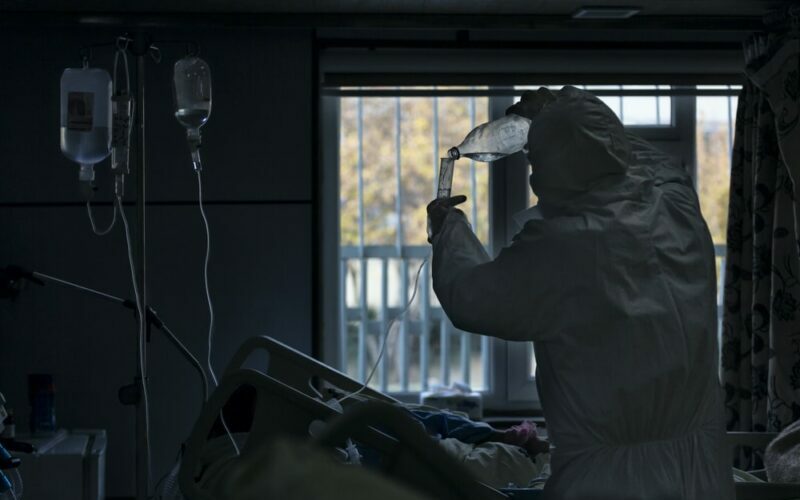Our post-pandemic healthcare system will need massive investment
January 17, 2022
Understaffed hospitals and care facilities, burgeoning surgery backlogs, insufficient medical graduates, rising mental health problems the list of challenges ahead is formidable.
When the coronavirus pandemic is brought under reasonable control which may not be this year, given the risk of further variants and the calibre of present government management Australia will face the need for national reconstruction that would tax the abilities of any good nation-builder and leader. It wont be Scott Morrison, who has never gotten ahead of a problem in all his time in government.
At the end of this month, COVID-19 will have been in Australia for two years. Since its arrival it has disrupted the operations of many hospitals and health centres, caused tens of thousands of health workers to be diverted from their normal roles, and created a serious backlog of increasingly urgent surgeries and other treatments. Up to 2 million Australians are on hospital waiting lists for planned elective surgery. Many thousands of them have been waiting for more than two years. The real line is in fact much longer perhaps 50 per cent longer because some people have not sought treatment they know is not available because surgery theatres, intensive care units and hospital beds have been diverted to the urgent needs of coronavirus patients.
As we have seen over recent weeks, the strain put on the health workforce by the pandemic has virtually brought the system to breaking point, with exhausted workers being asked to cover the shifts of others who are burnt out, sick, stressed out or actually leaving the healthcare system. This problem is not confined to hospital care as it has also affected the numbers and the energy available in aged care institutions, in screening and vaccination programs and in coping with the increasing numbers of infected people in isolation. Even as programmed and planned tasks have been achieved, for example in vaccination programs, the complexity of the challenge has steadily increased with the need for booster shots and the vaccination of primary school students.
I do not suggest that our health authorities, or their political masters, are oblivious to the problems, which may well result in a 10 per cent increase in normal demand for health services for the next five years, with a medical workforce that may be smaller than now. Certainly, the system is not recruiting or training medical workers primarily doctors and nurses but also allied health workers on anything like the scale that is necessary, in spite of umpteen warnings about increased demand, for example in aged care.
The gruelling work of the pandemic even at high risk and on comparatively low pay may have some inverted effect of providing extra status, purpose and meaning, as well as job satisfaction. But it has stretched many to the limit. It has put their relationships and lives with their families at risk, and reminded many that there are better paid jobs with far less stress. Nursing turnover has always been high, in part because of low pay, but it is increasing.
The crisis has also put doctors under stress, including in the community stress aggravated, in many cases, by the failure of politicians and the government to deliver on promises on the availability of vaccines, test kits and other supports. But there are particular problems with many medical specialties, with simply not enough specialists being trained, or available, to deal even with routine demand, let alone significant backlogs. In many disciplines, the problem is aggravated by the tight control of output by professional colleges seemingly determined to limit supply so as to maintain very high remuneration.
All up, the system may need the equivalent of an extra Westmead-sized hospital in NSW, fully staffed including with specialists, the equivalent in Victoria, and, in each state and territory, a new fully staffed hospital of at least the size of the states biggest over the next few years. On top of that, the system may require a 50 per cent increase in trained nursing carers in aged care homes and a doubling of community-based care staff. This reflects not only the size of backlogs but also years of cutbacks, reduced capacity and ebbing expertise so amply demonstrated during the pandemic.
The practical consequences of these backlogs, and the sharp increases in costs and demand for services, will fall on the states and territories. But such challenges cannot be simply dismissed by the Commonwealth as problems for the states, as the provision of rapid antigen testing equipment was said to be by Morrison recently. They have been predictable consequences of a national emergency, as was the extra Commonwealth spending to bolster businesses and employment. The challenges call for substantial Commonwealth investment in new healthcare facilities, in policies to increase the size and quality of the medical workforce, and in rebuilding a public health system that will reduce the need for and cost of acute care facilities such as hospitals and aged homes, promote a generally healthier population and maintain a workforce to deal with future health crises.
It is not simply a matter of catching up with the backlog of surgery, most of which will be fully cost-effective in the sense that it enhances the quality of life of the patients and allows them more years of active life in the community rather than as people with disabilities
Its also a matter of catching up with patients undergoing care for cancer and other serious conditions, many of whom have had less than adequate care or access to specialist facilities over the past few years. And of catching up with undiagnosed patients through screening programs that have been forced to take second place or been scratched altogether, and dealing with mental health issues, some of which have been neglected during the pandemic or caused or aggravated by the pandemic itself. As well, a significant number of people now have long Covid long-term symptoms that require continuing treatment.
Waiting lists are, of course, always politically sensitive, and, like budgets, often manipulated by administrators and ministers who appreciate that one can turn the tap on and off at will. But the backlog is no mere waiting list, and denying the theatre space, staff and resources to getting them down would be an entirely false economy. It would first, be transferring the real cost to the patients themselves, forced to cope with poor health, and reduced capacity to lead useful lives of dignity within the community. It is also to load costs often greater ones into other parts of the health system, forced to cope with the consequences of denied or delayed treatment.
A parliamentary committee looking into similar backlogs in Britain warns against a mere focus on targets that are able to be weighed, measured and counted. Doing so recording progress by the length of the surgical waiting list for example risks deprioritising equally important areas such as primary care, the provision of health services in the community and mental health services all of which play a crucial role in keeping people healthy and out of intrinsically expensive places such as hospitals.
There is also a risk that a new targets culture has unintended consequences, including compromises in the quality and safety of patient care. This is not a hypothetical concern considering that precisely this unintended consequence arose the last time tackling large waiting lists was a political priority.
Hidden demand, the parliaments health and social care committee said, includes not just missing patients people simply not seen identified over the past two years but people with mental health issues exacerbated by lockdowns and people with medical conditions who have faced interruptions to their usual care and whose health may have worsened as a result. There is also a backlog in public health, where children have missed out on universal programs largely delivered at school. The committee said it had heard powerful testimony from patients who had felt abandoned by the national health system, who had had to fight for care, and for whom delays in treatment meant ongoing uncertainty, with lives left on hold.
Part two will appear on Wednesday.

